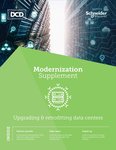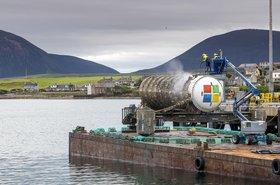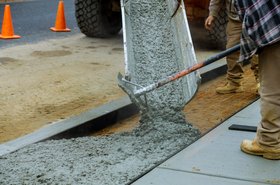It’s no secret that today’s data centers are designed and built to be ultra-efficient. In fact, the Uptime Institute states that “by using the latest technology and practices, most new builds fall somewhere between a PUE of 1.2 and 1.4.”
While from a sustainability perspective that’s a positive story, often meaning that the facility will have a lower carbon footprint and thereby omit less CO2, there’s still a significant challenge to be met in the face of legacy facilities, where PUEs remain around the 2.0 mark, or higher.
Today Statista research suggests that the number of data centers in the world will actually decrease from 8.5 million in 2015 to an estimated 7.2 million by the end of this year. Such a decrease can largely be attributed to data center consolidation, mainly due to the rise in public cloud and hyperscale facilities. In other words, more businesses are beginning to outsource their requirements into a smaller number of larger and more efficient data centers. And as hyperscale and colocation utilization rates continue to grow, they often replace inefficient facilities operating at a higher PUE.
Nevertheless,the number of hyperscale data centers, according to Synergy Research Group, is only 541, with another 176 planned in future. Add in around 5000 colocation sites across the world, it still leaves several million ‘other’ data centers - how many of which are legacy or inefficient remains to be seen.
At this stage, obtaining an accurate figure of global data center numbers and type is a far from an exact science, but, it is safe to say that the number of legacy sites, with a relatively high PUE, is a significant section of the market that needs urgent attention - especially in terms of sustainability.
Sustainability considerations
Today there are many sustainability drivers for legacy owners and operators to choose from. Customer interest in reducing the impacts of climate change continues to grow, governments are driving green agendas, and many members of the millennial generation continue to ask challenging questions regarding the ethics of business.
Within the sector, hyperscalers and cloud providers characterize themselves as sustainability champions. And while renewable energy sources, innovations in power and cooling and deployment locations are all ways in which sustainability objectives can be met, the hyperscale community has a significant advantage over companies, in that their size, scale and demand are also some of the main drivers behind the build out of new capacity.
Another factor is that data center customers are pursuing their own sustainability agenda. In the early days, this might have meant little more than a procurement exercise to satisfy shareholders or meet Corporate Social Responsibility (CSR) requirements. Nowadays, however, more organizations are looking at the sustainability credentials of their supply chains. Questions concerning PUE, renewables and overall energy efficiency achievements may well be asked of data center operators – whether operated on or off-premise.
Finally, hovers the threat of tighter regulation. This could be at the local, national, regional or global level. Many high profile and influential operators are committing to Net Zero via the Climate Neutral Data Center Pact, which aims to influence legislation and decision-making across at policy level across the European continent.
Of course, there are two ways to approach the intangibles of future legislation. One involves carrying on as normal, with fingers crossed that all will be OK: hiding in the hope that new rules and regulations will not be introduced. However, if they are, and an organization has not prepared, then the disruption will be significant, and one may argue it’s completely irresponsible for a business operating in the digital infrastructure sector to bury it’s head in the sand.
The other approach is to recognize that the industry will soon come under closer governmental scrutiny, and operators should be prepared ahead of the likely legislative curve. Moreover, those making the rules will see what hyperscalers are achieving voluntarily, and expect the rest of the market to meet similar standards.
Where to begin?
Right now, if you recognize that you are a legacy data center owner and have ambitions to become more sustainable or efficient, then a number of choices are available to you. For the enterprise market, the choices range from embarking on a major modernization initiative within your on-premise facility, to moving more of your IT assets into hosted facilities or the cloud.
Conversely, for colocation operators who need to improve their sustainability credentials, the only choice is to plan and execute a sustainable modernization strategy. Or, to consider closing your existing data center and instead build new, highly efficient facilities at an increased capital cost.
In both scenarios, understanding the extent of the challenge you face and setting your objectives are the first steps towards making what we might call a sustainable modernization decision. However, it all starts with the data, and if you can’t measure, analyze or benchmark your current operating status, you can’t and will not improve it
Start with the end in mind
For many years data center software has offered users greater analytical insight into the operating status of their mission-critical IT. In fact, its role has become so pivotal that technologies such as Computational Fluid Dynamics (CFD) have been instrumental in the fight to reduce data center carbon emissions.
By beginning with a free CFD analysis and utilizing the subsequent environmental report, operators can gain valuable insight into a facilities level of energy efficiency. But more importantly, they can also identify a range of modernization solutions, which will help to improve both performance and sustainability criterion - ranging from quick fixes to long-term strategic gains.
Such strategies may include optimizing your infrastructure system by improving airflow or cooling to the racks, eliminating hotspots, increasing IT densities and operating temperatures, or deploying a containment solution to minimize wasted cooling energy. In fact upgrading your facility with a new containment solution can improve the average data center PUE by a figure of 0.4 – meaning lower energy usage, decreased carbon emissions and a 30 per cent reduction in operating costs.
As the industry focuses on becoming more sustainable, I believe that beginning with legacy facility modernization, holds the key to its success. From a strategic perspective, a modernization plan that looks at three stages – analysis, optimization and performance - offers many benefits to the end-user. Not least of which is a streamlined and efficient solution to help reduce your data centers carbon footprint.





